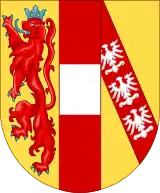| Archduchess Gisela of Austria | |
|---|---|
.jpg.webp) | |
| Born | 12 July 1856 Laxenburg, Lower Austria, Austrian Empire |
| Died | 27 July 1932 (aged 76) Munich, Bavaria, Weimar Republic |
| Burial | |
| Spouse | |
| Issue | |
| House | Habsburg-Lorraine |
| Father | Franz Joseph I of Austria |
| Mother | Elisabeth in Bavaria |
Archduchess Gisela Louise Marie of Austria (12 July 1856 – 27 July 1932) was the second daughter and eldest surviving child of Emperor Franz Joseph I and Empress Elisabeth of Austria. She became a Princess of Bavaria through her marriage to her second cousin, Leopold.
The Archduchess was born on 12 July 1856, the second child of Franz Joseph I of Austria and Elisabeth in Bavaria. She was named Gisella Louise Marie, which the name Gisella was named after Queen Gisela of Hungary, wife of Stephen I, first Christian Hungarian king.[1] Although christened Gisella, she only ever wrote her name with one L. Just like her elder sister Archduchess Sophie and her brother Crown Prince Rudolf, Gisela was raised by her paternal grandmother, Archduchess Sophie of Austria. Of a sober nature like her father, she kept a reserved attitude towards her mother. She had a very close relationship with her brother, whose suicide affected her greatly.
Life
Her father collected some of the family's personal items, such as the first pair of shoes worn by each of his children. Among these keepsakes was a poem written for him by a young Gisela one Christmas; the poem was said to be the most treasured item among this collection. Archduchess Gisela was also known to paint in her later years.
Marriage and family
On 20 April 1873, at the age of 16, Gisela was married to Prince Leopold of Bavaria in Vienna. Prince Leopold was a son of Prince Regent Luitpold of Bavaria and Auguste Ferdinande of Austria: Gisela's second cousin. Leopold had initially fallen for Princess Amalie of Saxe-Coburg and Gotha, whom Empress Elisabeth's younger brother Duke Maximilian Emanuel in Bavaria intended to marry. The Empress therefore arranged an encounter of Leopold and Gisela at Gödöllő Palace, and the prince knew he could not refuse her offer.
According to a letter to his mother written in 1872, Emperor Franz Josef wanted the match between his daughter and the Wittelsbach prince, as there were so few Catholic princes available at that time. It seems he felt he had to secure the only viable candidate to whom he could give Gisela (whom he called "our darling girl" during the wedding rites) with confidence. Prince Leopold received the immense dowry of a half a million guilders and soon overcame his former infatuation with Princess Amalie.
.jpg.webp)
Gisela's mother remained absent during the wedding celebrations. The young couple was made welcome in Munich by her husband's family and went on to live in the Palais Leopold residence in Schwabing. The Palais was renamed Giselastraße in her honor in 1873.
Issue

A year after her wedding, she gave birth to her first child and even Empress Elisabeth was present during the baptism. Gisela and Leopold had four children in total:
- Princess Elisabeth Marie of Bavaria (1874–1957), who married Count Otto Ludwig Philipp von Seefried auf Buttenheim
- Princess Auguste Maria of Bavaria (1875–1964), who married Joseph August, Archduke of Austria
- Prince Georg of Bavaria (1880–1943), who married Archduchess Isabella of Austria
- Prince Konrad of Bavaria (1883–1969), who married Princess Bona Margherita of Savoy-Genoa
Charity works and World War I
Especially after the death of her brother, Gisela was deeply involved in a variety of social and political issues and founded charities to support the poor, blind, and deaf people where she took an active role herself. During World War I she ran a military hospital in her Palais while her husband was a field marshal on the eastern front. When the Revolution broke out in 1918, the rest of her family fled the city, but Gisela remained and took part in the 1919 elections for the Weimar National Assembly where women above the age of 20 were allowed to vote for the first time.
Such was the esteem in which she was held that she was commonly known as the Good Angel from Vienna and became patron for a number of institutions, such as the Giselabahn (a train running from Salzburg to Tirol), the still active paddle steamer Gisela on the Traunsee and the Gisela Gymnasium in Munich.
Widowhood and death
Gisela and her husband celebrated their golden wedding anniversary in 1923. Her husband died in 1930; Gisela only survived him by two years. She died aged 76 in Munich on 27 July 1932, and is buried next to Prince Leopold in the Colombarium at the St.Michaelskirche, Munich.
Honours
She received the following orders:[2]
.svg.png.webp) Austria-Hungary:
Austria-Hungary:
- Dame of the Order of the Starry Cross
- Grand Cross of the Order of Elizabeth, 1898[3]
.svg.png.webp) Kingdom of Bavaria:
Kingdom of Bavaria:
- Dame of the Order of Theresa
- Dame of the Order of Saint Elizabeth
.svg.png.webp) Kingdom of Portugal: Dame of the Order of Saint Isabel
Kingdom of Portugal: Dame of the Order of Saint Isabel.svg.png.webp) Spain: 601st Dame of the Order of Queen Maria Luisa, 29 January 1863[4]
Spain: 601st Dame of the Order of Queen Maria Luisa, 29 January 1863[4]
Ancestry
| Ancestors of Archduchess Gisela of Austria | |||||||||||||||||||||||||||||||||||||||||||||||||||||||||||||||||||||||||||||||||||||||||||||||||||||||||||||||||||||||||||||||||||||||||||||||||||||||||||||||||||||||||||||||||||||||||||||||||||||||||||||||||||||||||||||||||||||||||||||||||||||||||||||||||||||||||||||||||||||||||
|---|---|---|---|---|---|---|---|---|---|---|---|---|---|---|---|---|---|---|---|---|---|---|---|---|---|---|---|---|---|---|---|---|---|---|---|---|---|---|---|---|---|---|---|---|---|---|---|---|---|---|---|---|---|---|---|---|---|---|---|---|---|---|---|---|---|---|---|---|---|---|---|---|---|---|---|---|---|---|---|---|---|---|---|---|---|---|---|---|---|---|---|---|---|---|---|---|---|---|---|---|---|---|---|---|---|---|---|---|---|---|---|---|---|---|---|---|---|---|---|---|---|---|---|---|---|---|---|---|---|---|---|---|---|---|---|---|---|---|---|---|---|---|---|---|---|---|---|---|---|---|---|---|---|---|---|---|---|---|---|---|---|---|---|---|---|---|---|---|---|---|---|---|---|---|---|---|---|---|---|---|---|---|---|---|---|---|---|---|---|---|---|---|---|---|---|---|---|---|---|---|---|---|---|---|---|---|---|---|---|---|---|---|---|---|---|---|---|---|---|---|---|---|---|---|---|---|---|---|---|---|---|---|---|---|---|---|---|---|---|---|---|---|---|---|---|---|---|---|---|---|---|---|---|---|---|---|---|---|---|---|---|---|---|---|---|---|---|---|---|---|---|---|---|---|---|---|---|---|---|---|---|
| |||||||||||||||||||||||||||||||||||||||||||||||||||||||||||||||||||||||||||||||||||||||||||||||||||||||||||||||||||||||||||||||||||||||||||||||||||||||||||||||||||||||||||||||||||||||||||||||||||||||||||||||||||||||||||||||||||||||||||||||||||||||||||||||||||||||||||||||||||||||||
Notes
- ↑ Hamann, Brigitte (1986). The reluctant empress. Internet Archive. New York : Knopf. p. 68. ISBN 978-0-394-53717-7.
- ↑ Hof- und Staatshandbuch der Österreichisch-Ungarischen Monarchie (1915), Genealogy p. 1
- ↑ "Elisabeth-orden", Hof- und Staatshandbuch der Österreichisch-Ungarischen Monarchie, Vienna: Druck und Verlag der K.K. Hof- und Staatsdruckerei, 1899, p. 192
- ↑ Guía de forasteros en Madrid para el año de 1864 (in Spanish). En la Imprenta Nacional. 1864. p. 168. Retrieved 17 March 2019.
